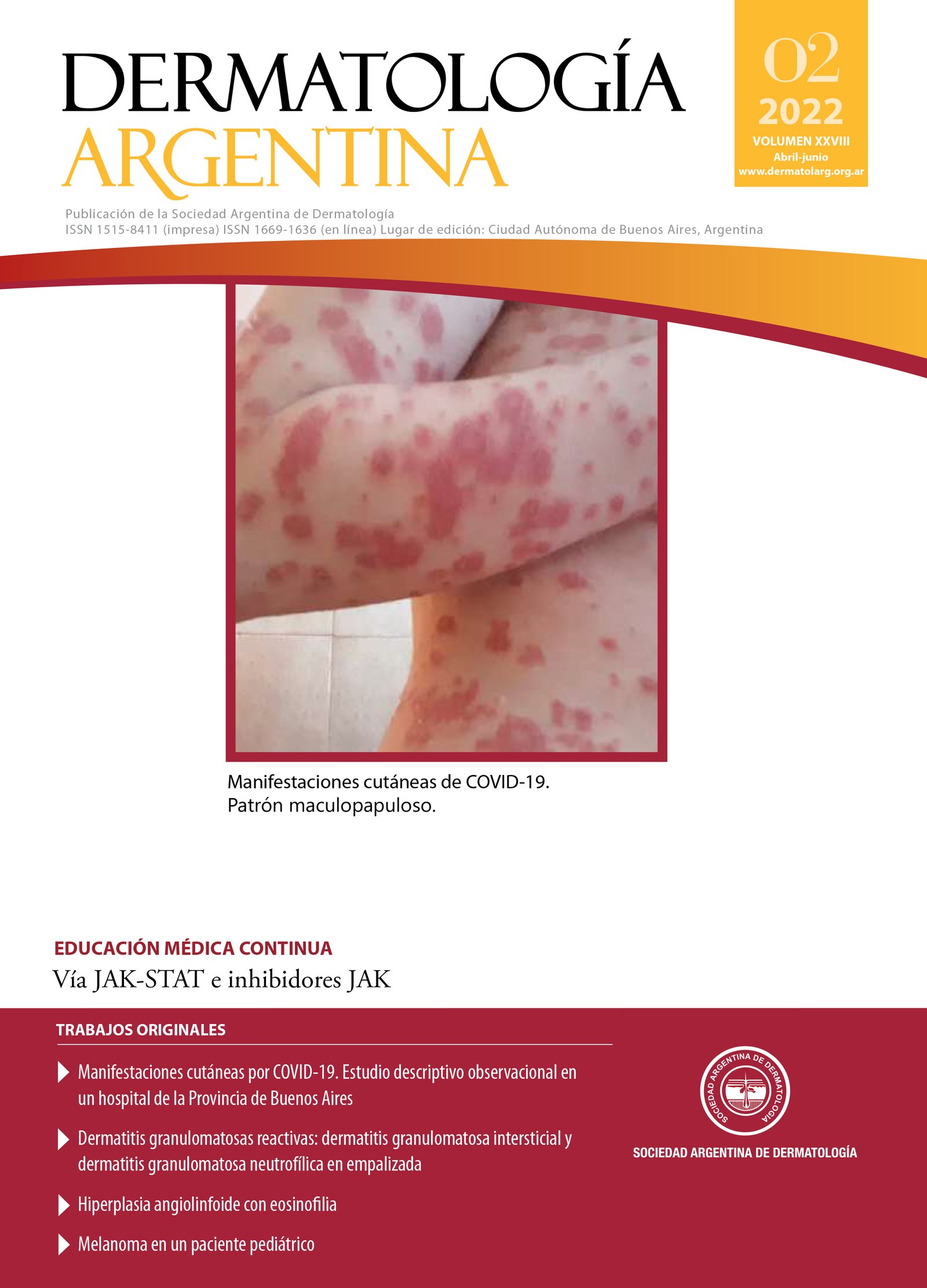JAK-STAT pathway and JAK inhibitors
DOI:
https://doi.org/10.47196/da.v28i2.2324Keywords:
JAK-STAT, JAK inhibitors, immunemediated skin diseasesAbstract
The JAK-STAT (Janus Kinase) pathway is an intracellular signal translation chain that is activated through cytokine I and II receptors.
Through this pathway, several molecules of importance in dermatology exert their effects: IL2, IL4, IL7, IL5, IL6, IL9, IL12, IL13, IL15, IL21, IL23, INFα and INFβ, among others. It is also the intracellular signal for hormones such as prolactin and growth hormone.
The inhibition of different components of this pathway is used as therapeutics in rheumatological diseases and an increasing number of skin pathologies.
JAK inhibitors emerged in medical practice approximately 11 years ago, with ruxolitinib and soon after tofacitinib. Currently, there are several approved molecules and many others in the experimental stage.
This article will develop the intracellular organization and functions of the JAK-STAT pathway with its main variants related to immune-mediated diseases, as well as the most relevant characteristics of JAK inhibitors.
References
I. Hu XLJ, Fu M, Zhao X, Wang W. The JAK/STAT signaling pathway: from bench to clinic. Signal Transduct Target Ther 2021;6:402.
II. Jiménez GA, Vélez Hoyos A, Buchelli Ibarra N. Mitología griega y romana asociada con algunos términos en patología. Patología 2020;58:1-11.
III. Chapman S, Kwa M, Gold LS, Lim HW. Janus kinase inhibitors in dermatology: Part I. A comprehensive review. J Am Acad Dermatol. 2022;86:406-413.
IV. Wan YY, Flavell RA. How diverse–CD4 effector T cells and their functions. J. Mol. Cell Biol 2009;1:20–36.
V. Garcia-Melendo C, Cubiró X, Puig L. Inhibidores de JAK: usos en dermatología. Parte 1: generalidades, aplicaciones en vitíligo y en alopecia areata. Actas Derm Sifilogr 2021;112: 503-515.
VI. Xin P, Xu X, Deng C, Liu S, et ál. The role of JAK/STAT signaling pathway and its inhibitors in diseases. Int Immunopharmacol 2020;80:106210. doi: 10.1016/j.intimp.2020.106210. Epub 2020 Jan 20.
VII. Damsky W, Peterson D, Ramseier J, Al-Bawardy B, et ál . The emerging role of Janus kinase inhibitors in the treatment of autoimmune and inflammatory diseases. Journal of Allergy and Clinical Immunology.2021; 147 814–826.
VIII. Kotyla PJ, Engelmann M, Giemza-Stokłosa J, Wnuk B, et ál . Thromboembolic Adverse Drug Reactions in Janus Kinase (JAK) Inhibitors: Does the Inhibitor Specificity Play a Role?. Int J Mol Sci. 2021;22(5):2449. Published 2021 Feb 28. doi:10.3390/ijms22052449
IX. Howell MD, Kuo FI, Smith PA. Targeting the Janus Kinase Family in Autoimmune Skin Diseases. Frontiers in immunology 2019;10:2342. https://doi.org/10.3389/fimmu.2019.02342
X. Wan YY. GATA3: a master of many trades in immune regulation. Trends Immunol 2014;35:233-242.
XI. Wan YY, Flavell RA. How diverse–CD4 effector T cells and their functions. J. Mol. Cell Biol 2009;1:20–36.
XII. Jiang Q, Yang G, Xiao F, Xie J, et ál. Role of Th22 Cells in the Pathogenesis of Autoimmune Diseases. Front Immunol. 2021;12:688066. Published 2021 Jul 6. doi:10.3389/fimmu.2021.688066
XIII. Chakraborty S, Kubatzky KF, Mitra DK. An Update on Interleukin-9: From Its Cellular Source and Signal Transduction to Its Role in Immunopathogenesis. Int J Mol Sci. 2019;20:2113. Published 2019 Apr 29. doi:10.3390/ijms20092113
XIV. Tanaka Y, Luo Y, O’Shea JJ, Nakayamada S. Janus kinase-targeting therapies in rheumatology: a mechanisms-based approach. Nat Rev Rheumatol 2022;18: 133–145.
XV. Ciechanowicz P, Rakowska A, Sikora M, Rudnicka L. JAK-inhibitors in dermatology. Current evidence and future applications. J Dermatolog Treat 2019;30:648-658
XVI. Clarke B, Yates M, Adas M, Bechman K, et ál. The safety of JAK-1 inhibitors. Rheumatology (Oxford). 2021;60(Suppl 2):ii24-ii30. doi:10.1093/rheumatology/keaa895
XVII. Alharthi S, Turkmani MG, AlJasser MI. Acne exacerbation after tofacitinib treatment for alopecia areata. Dermatol Reports. 2022;14:9396. Published 2022 Jan 1. doi:10.4081/dr.2022.9396
XVIII. Hoisnard L, Lebrun-Vignes B, Maury S, Mahevas M, , et ál . Adverse events associated with JAK inhibitors in 126,815 reports from the WHO pharmacovigilance database. Scientific reports 2022;12:7140. https://doi.org/10.1038/s41598-022-10777-w
XIX. Kragstrup TW, Glintborg B, Svensson AL, McMaster, et ál . Waiting for JAK inhibitor safety data. RMD open 2022. 8; e002236. https://doi.org/10.1136/rmdopen-2022-002236
XX. Ozdede A, Yazıcı H. Cardiovascular and Cancer Risk with Tofacitinib in Rheumatoid Arthritis. N Engl J Med. 2022;386(18):1766.
XXI. U. S. Food & Drug Administration. FDA requires warnings about increased risk of serious heart-related events, cancer, blood clots, and death for JAK inhibitors that treat certain chronic inflammatory conditions, https://www.fda.gov/drugs/drug-safety- and-availability/fda-requires-warnings-about-increased- risk-serious-heart-related-events-cancer-blood-clots- and-death (2021).
XXII. Elmariah SB, Smith JS, Merola, J. F. JAK in the [Black] Box: A Dermatology Perspective on Systemic JAK Inhibitor Safety. American journal of clinical dermatology 2022;23:427–431.
XXIII. Setyawan J, Azimi N, Strand V, Yarur A, , et ál . Reporting of Thromboembolic Events with JAK Inhibitors: Analysis of the FAERS Database 2010-2019. Drug safety 2022 ;44: 889–897.
Downloads
Published
Issue
Section
License
Copyright (c) 2022 Argentine Society of Dermatology

This work is licensed under a Creative Commons Attribution-NonCommercial-NoDerivatives 4.0 International License.
El/los autor/es tranfieren todos los derechos de autor del manuscrito arriba mencionado a Dermatología Argentina en el caso de que el trabajo sea publicado. El/los autor/es declaran que el artículo es original, que no infringe ningún derecho de propiedad intelectual u otros derechos de terceros, que no se encuentra bajo consideración de otra revista y que no ha sido previamente publicado.
Le solicitamos haga click aquí para imprimir, firmar y enviar por correo postal la transferencia de los derechos de autor











